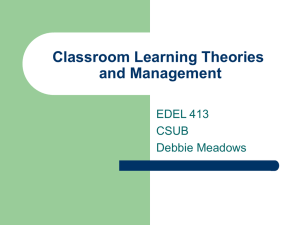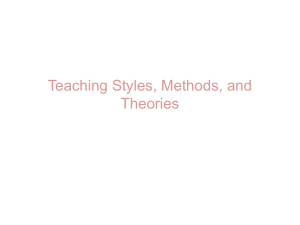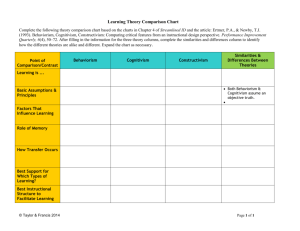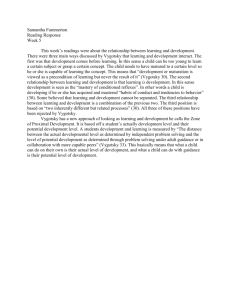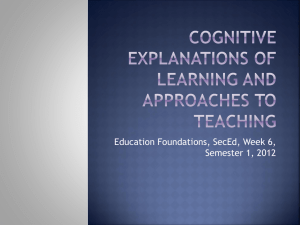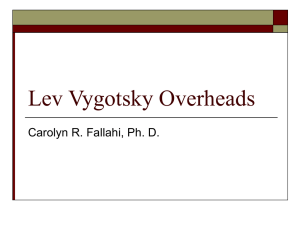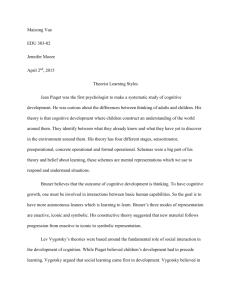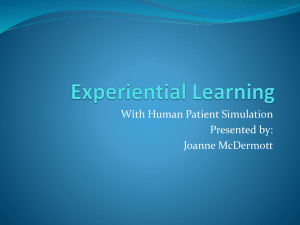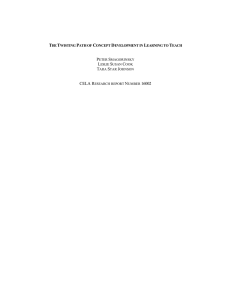Coaches+learning+theory-+prs-v1+00
advertisement
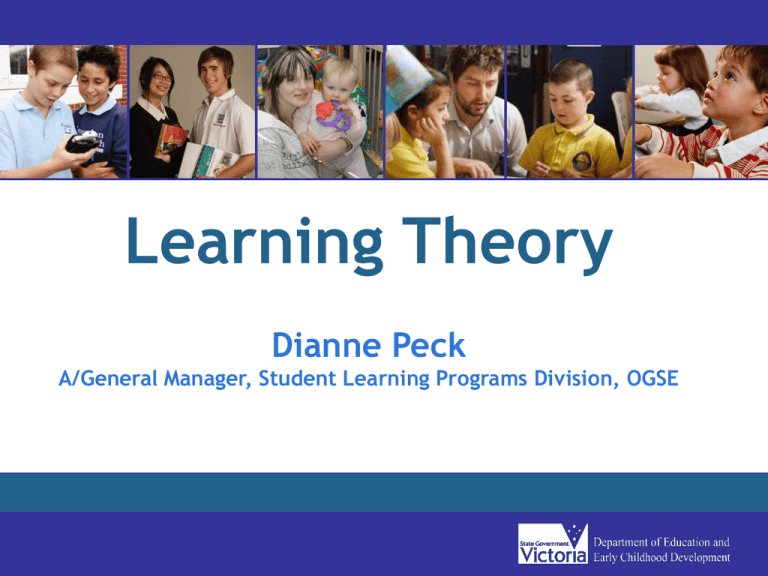
Learning Theory Dianne Peck A/General Manager, Student Learning Programs Division, OGSE Different definitions from different fields • Process by which the brain reacts to stimuli by making neuronal connections that act as an information processing circuit and provide information storage (Koizumi, 2003) • Significant changes in capability, understanding, attitudes or values of individuals, groups, organisations or society. (Coffield, 2005) Note: explicitly excludes the acquisition of information that does not contribute to such changes How does learning occur? Briggs Dewey Scandura Vygotsky Reigeluth Piaget Wager Gagne Bandura Skinner Rorty Bruner Thorndike Pavlov Vico Behaviourism All behavior caused by external stimuli (operant conditioning). All behavior can be explained without the need to consider internal mental states or consciousness. Originators and important contributors: John B. Watson, Ivan Pavlov, B.F. Skinner, E. L. Thorndike (connectionism), Bandura, Tolman (moving toward cognitivism) The ‘empty vessel’ view of education Cognitivism This paradigm essentially argues that the “black box” of the mind should be opened and understood. The learner is viewed as an information processor (like a computer). Originators and important contributors: Merrill -Component Display Theory (CDT), Reigeluth (Elaboration Theory), Gagne, Briggs, Wager, Bruner (moving toward cognitive constructivism), Schank (scripts), Scandura (structural learning) Keywords: Schema, schemata, information processing, symbol manipulation, information mapping, mental models Cognitivism Constructivism Constructivism posits that learning is an active, constructive process. The learner is an information constructor. People actively construct or create their own subjective representations of objective reality. New information is linked to prior knowledge, thus mental representations are subjective. Originators and important contributors: Vygotsky, Piaget, Dewey, Vico, Rorty, Bruner Keywords: Learning as experience, activity and dialogical process; Problem Based Learning (PBL); Anchored instruction; Vygotsky’s Zone of Proximal Development (ZPD); cognitive apprenticeship (scaffolding); inquiry and discovery learning. MAPS WINDOW ON THE WORLD X FINDING OUT EVENTS AND THINGS TAKING ACTION BAG OF TRICKS Richard Bawden's Visual representation of Kolb's (Kolb 1984) Building on what students know and are able to do Mediated Learning - Diagnosis - Scaffolding - Focus attention Teaching is PURPOSEFUL (Vygotsky) How People Learn http://www.nap.edu/html/howpeople1/ • Research on human learning, inc. new developments from neuroscience • Learning research with implications for P-12 • Research that explores possibility of all individuals achieve their fullest potential (2000) How People Learn Students come to the • classroom with preconceptions about how the world works. If their initial understanding is not engaged, they may fail to grasp the new concepts and information that are taught, or they may learn them for purposes of a test but revert to their preconceptions outside the classroom. Teachers must draw out and work with the pre-existing understandings that their students bring with them. How People Learn To develop competence in an • area of inquiry, students must a) Have a deep foundation of factual knowledge b) Understand facts and ideas in the context of a conceptual framework c) Organise knowledge in ways that facilitate retrieval and application. Teachers must teach some subject matter in depth, providing many examples in which the same concept is at work and providing a firm foundation of factual knowledge How People Learn A ‘metacognitive’ approach to instruction can help students learn to take control of their own learning by defining learning goals and monitoring their progress in achieving them. • The teaching of metacognitive skills must be integrated into the curriculum in a variety of subjects. Designing classroom environments 1. Schools and classrooms must be learner centred 2. Attention must be given to what is taught (information, subject matter), why it is taught (understanding) and what competence or mastery looks like. 3. Formative assessments are essential. 4. Requires the development of norms for the classroom and school, as well as connections to the outside world, that support core learning values. Two types of knowledge. ‘FRAGILE’ KNOWLEDGE can be: • Missing (exposed to, but can’t remember) • Inert (it’s there but you can’t do anything with it) • Naïve (simplistic, stereotypical or wrong) • Ritualistic (pattern useful for school task, nothing more) ‘GENERATIVE’ KNOWLEDGE focuses on: • Retention of knowledge AND • Understanding of knowledge AND • Active use of knowledge. requires ‘GOOD’ THINKING (David Perkins) A good performer in Maths…… • ‘I know what to do by looking at the examples. If there are only two numbers I subtract. If there are lots of numbers I add. If there are just two numbers and one is smaller than the other it is a hard problem. I divide to see if it comes out even and if it doesn’t I multiply.’ Perkins ‘Smart Schools’ p25 Understanding the Brain: The Birth of a Learning Science • Synthesises existing and emerging findings from cognitive and brain science • Information on: - Changes through life - Literacy - Numeracy - Neuromyths (2006) LEARNING THEORY Knowledge of the discipline Pedagogical content knowledge Generalised pedagogical knowledge EFFECTIVE TEACHING
